Punk is really more of a catch-all genre term than a unified sound; everything from Black Flag to The Clash to Television falls under the umbrella, but you’re unlikely to confuse any of those radically different bands for each other. If anything, punk is defined by an attitude more than any specific sound: it’s defiant, primal, and wholly cathartic. These are 11 of the best films about punk that embody that ethos of liberation through rock n’ roll.
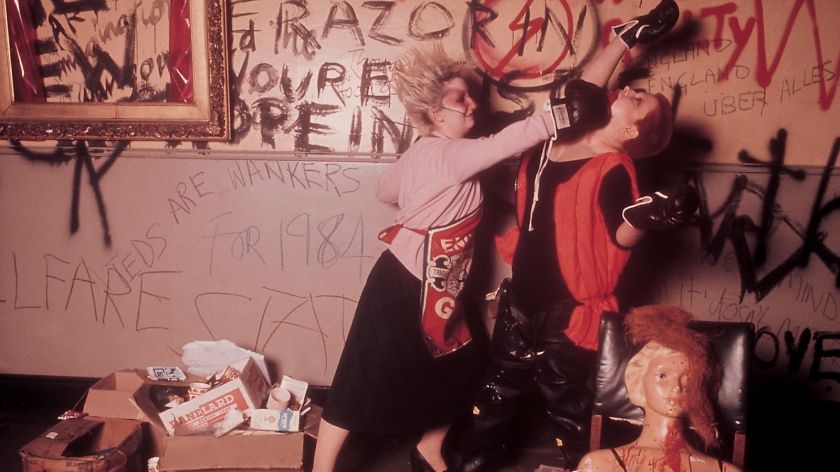
Jubilee (1978, Derek Jarman)
Derek Jarman was an iconoclast in everything he did; never one to make a conventional film, his work stretches from Blue – a solid blue screen with him providing voiceover for 90 minutes – to The Last of England – an impressionistic vision of the apocalypse with poetic narration in place of a plot or dialogue.
Jubilee is decidedly less extreme than those two films, but it’s still far from box-office-friendly. It’s hardly heavy on narrative, and what plot there is is pretty bleak; the story follows Queen Elizabeth I as she time travels hundreds of years forward to land in an alternate 1978, in which London is ruled by punk gangs and Queen Elizabeth II – the current Queen of England, please keep up – was killed in a mugging. There she meets Amyl Nitrate, leader of an all-female gang of punks who thrive in this post-apocalyptic London and take the anachronistic queen under their wing.
Vivienne Westwood, the fashion designer who co-manufactured the look of British punk when she designed clothes for the Sex Pistols, famously wrote a scathing (and very homophobic) essay denouncing the film as completely misrepresenting the punk movement; then again, the Sex Pistols were also carefully crafted by her and Malcolm McLaren for capitalistic gain, a veritable boy band in every sense but sonically, so what does Vivienne Westwood know about punk?
Jubilee is punk as fuck, regardless of what Westwood says; it’s politically charged, daringly experimental, and, above all, filmed with a raw anger that’s impossible to fake. Derek Jarman saw through the thinly veiled consumerism and artificiality lurking close beneath Westwood’s conception of punk, and thus his film is both a critique of her vision – Amyl Nitrate is unflatteringly based on Westwood and played by one of her most famous models, Jordan – and a more authentic depiction of punk, featuring musical performances by Adam Ant and Jayne County as well as cameos by the Slits and Siouxsie Sioux.
As the plot summary might indicate, it’s a campy movie that revels in a pretty trashy, over-the-top aesthetic – that much can’t be denied – but it’s also a rage-filled slap across the face of capitalism that sneers at the establishment with every frame, and one with a lot of genuine artistic merit at that; no wonder Vivienne Westwood hated it.
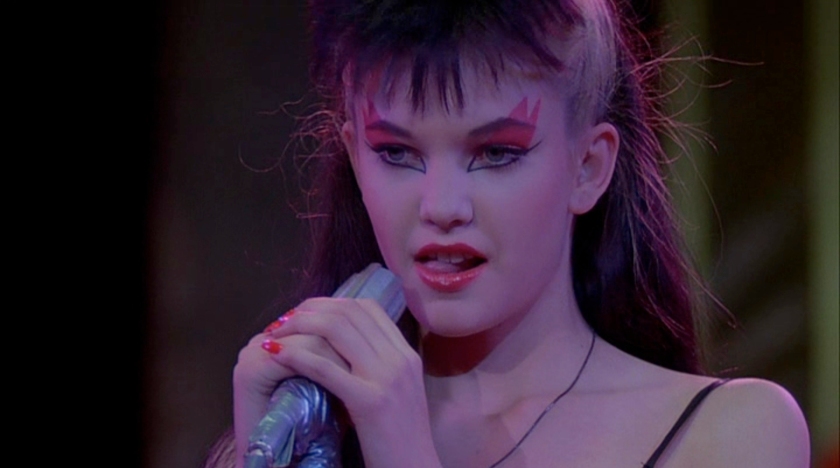
Ladies and Gentlemen, The Fabulous Stains (1982, Lou Adler)
Ladies and Gentlemen, The Fabulous Stains desperately deserves canonization as one of the great movies about rock music and teenage rebellion. Until it gets that much-needed recognition, it’s relegated to being a cult classic, a wildly charming yet underseen movie with arguably the most star-studded cast of any punk movie on this list.
15-year-old Diane Lane stars as Corinne Burns, a recently orphaned girl who, along with her sister and cousin respectively played by Marin Kanter and a teenage Laura Dern, decides to ditch the adults in her life and set out on tour in a punk band. The three of them end up as the opening act for an English punk band fronted by a baby-faced Ray Winstone and, with the help of some serendipitous media attention, rapidly transform into a national sensation.
Nearly every film critic reviewing the movie seems to revel in pointing out that the Stains are a talentless band and that Diane Lane can’t sing, but, with all due respect to The New York Times and their damning review, they will never understand punk. The band’s – and cast’s – lack of experience and technical skill is entirely irrelevant; punk is all about having more passion than raw talent, and the anger and energy in the music is practically palpable. The first song the band plays in the film, titled “Waste of Time,” could easily be a long-lost B-side from The Slits or The Raincoats; it’s hardly groundbreaking music, but it captures the spirit of rough-around-the-edges early-‘80s punk and post-punk surprisingly well.
The film itself is a brilliant combination of accessibility and punk credibility; it takes a lot of nerve to cast Paul Simonon, Steve Jones, and Paul Cook (of The Clash and Sex Pistols, respectively) as minor characters rather than putting them front-and-center, but The Fabulous Stains is a nervy film. One could argue that its formulaic structure belies that it’s a little too conventional to be a truly “punk” movie, but the confrontational feminist politics of the band and challenging look at youth culture surely makes it stand out as a sincere and deeply felt movie about teens in revolt.

Liquid Sky (1982, Slava Tsukerman)
Is Slava Tsukerman’s bizarre cult oddity Liquid Sky really a punk film? Maybe it’s more of a new wave film or an EDM film. It’s hard to even begin to slap a label on Liquid Sky simply because it evades easy summarization at every turn. Everything about it seems contradictory; it’s elegant and artful but also B-movie-esque and campy, an arthouse sci-fi film about junkie aliens and sexual politics directed by a Soviet ex-pat who also composed its avant-garde electronic score.
In short, it’s indescribably bizarre, yet by some miracle it not only forms a cohesive work of art but also arguably the most stylistically bold independent film of the 1980s. As a film that values style over substance in the best way possible, much of its appeal and originality lies in its sights and sounds rather than its narrative.
What narrative there is, however, is absolutely bonkers; aliens come to Earth searching for opiates, so naturally they decide to land at the easiest place to find them, a cheap New York City tenement where “liquid sky” (hint: that’s code for heroin in ‘70s/’80s NYC) flows like water. The apartment closest to that roof belongs to fashion model Margaret (Anne Carlisle), who spends much of her time in a new wave nightclub along with her rival male-counterpart Jimmy (also Anne Carlisle).
The aliens soon discover that the endorphins released in the brain during sex are incredibly similar to opiates on a molecular level, and thus they begin to kill off every man with whom Margaret has sex to feed off these endorphins. Margaret begins to use this to her advantage by luring the more unsavory characters in her life to deaths-by-orgasm.
That alone is a lot to process, but it’s even more layered when you factor in Anne Carlisle’s androgynous dual performances, the neon-drenched cinematography, and the bold punk fashion that’s either incredibly dated or ultra-modern.
It’s actually pretty unclear if the movie as a whole is wildly dated or ahead of its time. It has so many hallmarks of 1980s excess – wildly flamboyant fashion, drugs-on-drugs-on-drugs, and an inordinate amount of synth, among others – yet it hardly fits in amongst other ‘80s science-fiction movies. If anything it’s a film that would seem strange and mysterious in any decade, but it’s certainly infused with the gritty rebelliousness and cool-as-hell quality of late-‘70s punk and the louder, more glitzy essence of new wave music.
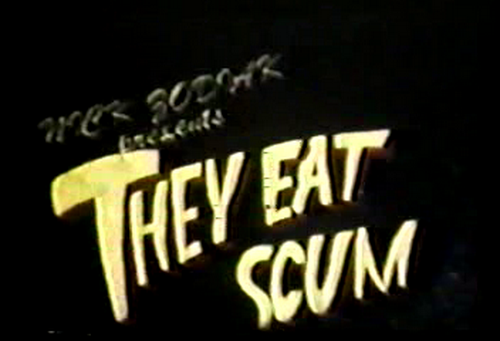
They Eat Scum (1978, Nick Zedd)
It’s hard to even begin to discuss Nick Zedd’s depraved horror-comedy They Eat Scum without first providing some historical context.
Late-‘70s New York City was a cultural mecca for punk musicians, but it didn’t take long for some artists to find even punk too conventional for their tastes. Thus no wave music was born, a noisy, dissonant offshoot of the punk scene that embraced nihilism and gave birth to bands like Sonic Youth, Swans, and Teenage Jesus & The Jerks.
The no wave scene was multidisciplinary though, and no wave cinema soon began to take hold of the city’s underground arts scene. Vincent Gallo, Jim Jarmusch, and Steve Buscemi – yes, Steve Buscemi – were perhaps the only no wave filmmakers to go on to achieve any degree of commercial success, but the movement was hardly about making money; instead it was about taking low-budget filmmaking to new extremes by rapidly churning out cheaper-than-cheap DIY films that were less focused on technical skill than they were on mood and style. The scene being as small and close-knit as it was, no wave musicians like Teenage Jesus frontwoman Lydia Lunch were almost always the stars of these films.
That’s where Nick Zedd comes into the picture. His no wave films stood out as far more shocking, more disturbing, more grimly hilarious than those of any other filmmaker in the scene, so he decided to start his own movement-within-a-movement: the cinema of transgression, made up of films that didn’t push the boundaries of good taste in terms of sexuality and violence but rather erased the boundaries altogether. Absolutely nothing was off-limits.
Zedd’s most popular film fits squarely into this movement; They Eat Scum is 24 frames per second of absolute filth, a no-budget film so trashy and amateurish it would make John Waters blush – and it likely did, as Waters is an outspoken fan of Zedd’s work.
The extraordinarily loose plot follows Suzi Putrid, the lead singer of a punk band and daughter of a televangelist preacher who tries desperately to pair her up with wholesome Christian boys despite her being attracted to women. Suzi’s brother Jimmy is hardly anymore of a good Christian; he walks around the house in drag and is a dog-lover in the most grotesque sense of the term.
Things quickly spirals out of control when Suzi and her band start to indulge in cannibalism with their cultish followers, leading the characters down a path involving evil twins, the nuclear apocalypse, a disco-fuelled mutant uprising (which is itself a visual pun on disco-influenced no wave bands given the genre label “mutant disco”), and so, so much tasteless violence.
If the film weren’t so cheaply made it might be genuinely horrifying, but because the plot is so excessive and the production value is so low it becomes a deliriously funny carnival of bad taste, a chaotic exercise in just how far a film can go with its humor.

The Blank Generation (1976, Amos Poe & Ivan Kral)
Less a conventional film than it is a vital artifact of the first wave of punk, The Blank Generation may be too bare-bones to even call a concert film. Consisting entirely of 16mm footage of New York punk bands playing at now-legendary venues like Max’s Kansas City and CBGB, it’s as DIY as documentary filmmaking can get.
That being said, it’s arguably one of the most important documents of the origins of American punk. The roster includes virtually every huge name in the New York scene you can think of: Patti Smith, Richard Hell, Talking Heads, Blondie, the Ramones, Television, and New York Dolls are all featured heavily, among others.
This being 1976, punk hadn’t fully broken through to the mainstream yet and thus every single artist in the film was virtually unknown outside of the local scene at the time, making it all the more stunning that they’re featured in such a modest little film.
Despite its humble appearance though, directors Amos Poe, who would go on to become a pioneering No Wave filmmaker, and Ivan Kral, the iconic guitarist who performed on Patti Smith’s first four albums and collaborated with Iggy Pop and Blondie, did infuse the film with some style.
In a decision that pays homage to the disjointed style of French New Wave director Jean-Luc Godard’s early work, the audio is out of sync with the footage of the bands performing; in fact, the audio isn’t even from the same sessions as the ones that are shown in the film.
The film is technically made up of silent footage the two directors shot at shows they attended, and after the shows they would put audio from the bands’ demo tapes and live recording – most if not all of the bands had yet to release their first album by the time the movie was being made – over their footage. The result is jarring and strange, but it definitely spices up what would otherwise be stylistically indistinguishable from a series of bootleg videos taken at concerts.
It’s hardly sophisticated from a cinematic perspective, but The Blank Generation documents the humble beginnings of the New York scene and thus American punk in general, and in that sense it’s essential viewing for anybody interested in the history of punk.
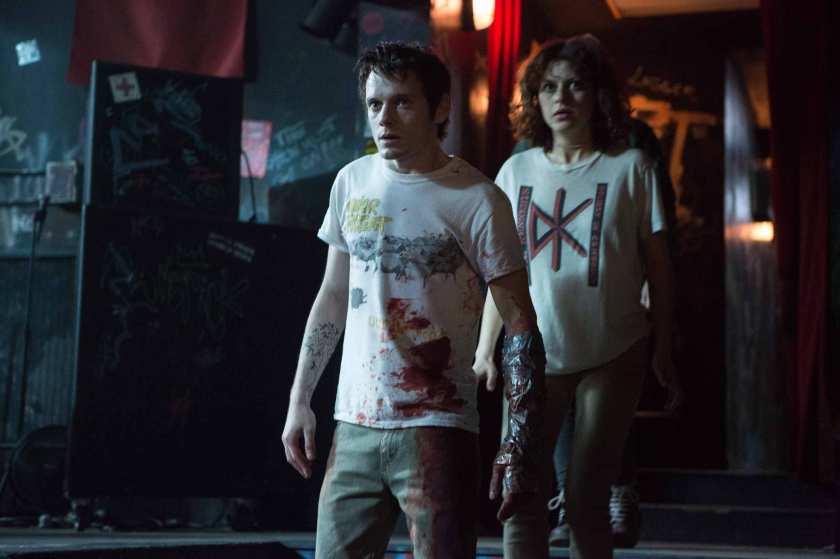 Green Room (2016, Jeremy Saulnier)
Green Room (2016, Jeremy Saulnier)
Green Room is positively brutal, a simple thriller that takes a classic premise – some people witness a murder and are targeted by the killers – and adds a fun, fresh twist on it: Nazi punks with machetes!
The song that should come to the mind of anybody even vaguely well-versed in punk – “Nazi Punks Fuck Off” by the Dead Kennedys – is actually present early in the film when the protagonists cover it in, naturally, a dive bar owned by skinheads. Their hardcore band, the Ain’t Rights, is on the last leg of an unsuccessful tour when they’re given this one last gig in the-middle-of-nowhere, Oregon, and they think it would be funny to antagonize the crowd because, hey, what’s the worst a bunch of neo-nazis can do?
Apparently quite a lot, because when they head backstage to get their equipment they accidentally find a girl from the crowd with a screwdriver in her head, courtesy of the gig’s headliners. The venue’s owner, a soft-spoken but still unfathomably evil man named Darcy (Patrick Stewart, playing against type to very creepy effect) decides that it’s cleaner to just kill off the entire band instead of leaving witnesses. So the band locks themselves in that titular green room backstage, desperate to escape the venue alive.
Of course, things get violent pretty quickly – shockingly violent, actually, even for a movie with a premise as intense as this one. The gore is never glorified or kept onscreen for too long, but when shotguns, machetes, and boxcutters are involved things are bound to get pretty messy.
The no-holds-barred bloodiness is hardly what makes the film so enjoyable though; rather, it’s the taut pacing that keeps things appropriately terrifying and suspenseful (read: really, really, incredibly stressful). The film is structured so tightly that there’s almost no breathing room from scene to scene, but the ultimate effect is perfect. Like the central band’s hardcore songs, the movie is fast, loud, and aggressive, without an inch of fat on its bones – no scene is expendable, nearly every moment is high-stakes.
Green Room is destined to become a midnight movie – it would be a challenge to make a movie about a Nazi punk bloodbath and not have it achieve cult status in record time – but it’s so brilliantly executed by director Jeremy Saulnier that perhaps it deserves even better than that. Saulnier, whose previous (and first) directorial effort was the 2013 Sundance hit Blue Ruin, has come so far from that debut feature; the clever dialogue and tense narrative alone attest to that. It’s only a matter of time before he’s offered to direct a more polished studio film with mainstream appeal, but thank god he made this gruesome little genre film first.
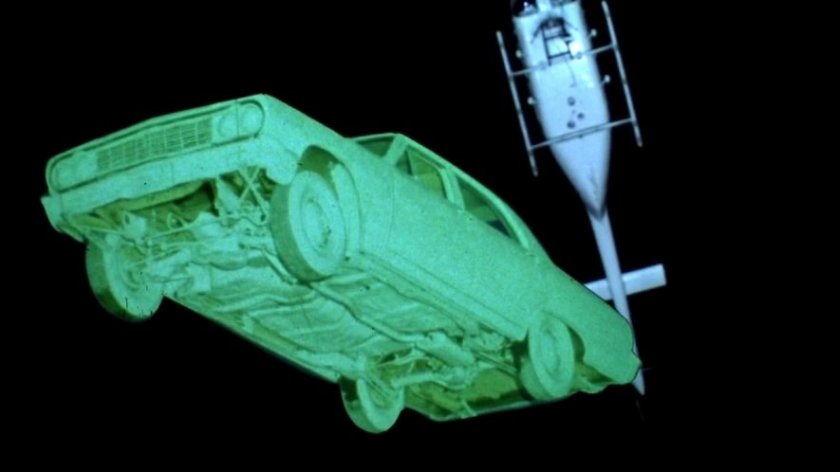
Repo Man (1984, Alex Cox)
How does one describe Alex Cox’s offbeat cult masterpiece Repo Man? Well, for starters, it’s Emilio Estevez’s career peak; forget The Breakfast Club, his role as punk-turned-grocery-clerk-turned-repo-man Otto is indisputably his best and most iconic.
Harry Dean Stanton is equally flawless as the repo man who lures Otto into his unique line of work, which in turn draws them both into a bizarre FBI conspiracy involving a Chevy Malibu with expensive – and deadly – extraterrestrial cargo in the trunk.
Otto aside, the movie itself is punk as hell, thanks in large part to a near-perfect soundtrack featuring everyone from Circle Jerks to Iggy Pop to Black Flag. Brilliantly innovative use of a shoestring budget only adds to the DIY aesthetic; it’s a cheap movie at a meager budget of $1.5 million, but that money goes a long way.
The low-budget special effects, particularly in the unforgettable final scene, are reminiscent of sci-fi B-movies from the 1950s, but none of those movies were half as clever and biting as this one.
Alex Cox’s satire is aimed squarely at consumer culture, cold war nuclear fears, and conservative society in the age of Reagan, filled with unbridled rage even in its funniest moments. Ultimately, in its own strange way, Repo Man is a protest movie, albeit one of the most eccentric and purely fun ones of the late-20th century.
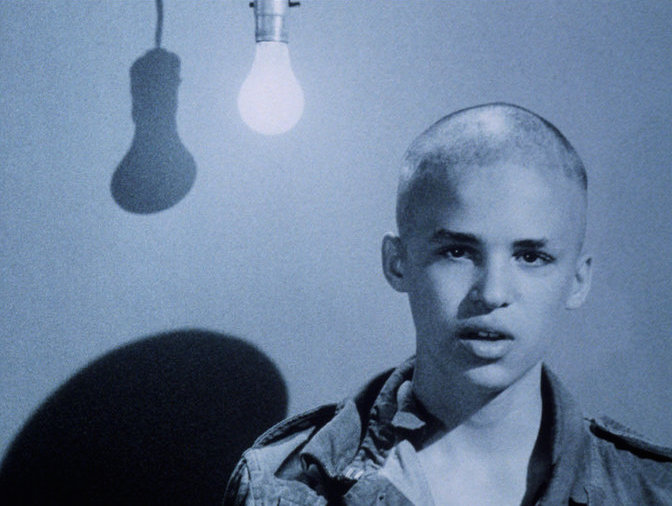
The Decline of Western Civilization (1981, Penelope Spheeris)
Penelope Spheeris is the patron saint of punk filmmaking, and The Decline of Western Civilization is her opus. It’s nearly impossible to have a discussion about punk cinema without this film coming up, it being without a doubt the most compelling and thorough document of the early-‘80s hardcore scene ever set to celluloid.
The Los Angeles hardcore scene was the first to pop up and arguably the most important, along with the Washington D.C. scene that appeared about a year later. Spheeris’ documentary covers seminal L.A. punk bands like X, Black Flag, Germs, Circle Jerks, and Fear from 1979 to early 1980, before any of them had even released albums.
Made up of interviews with the musicians along with footage of their chaotic live performances – often with subtitles, which is helpful for bands like Germs that utilize surprisingly thoughtful lyrics but weren’t really inclined to enunciate when screaming them – the film depicts the scene with the same viciousness and passion as the music that makes it up.
Many scenes are wildly absurd to the point of being funny – Germs drummer Michelle Baer tells a story about finding a painter’s dead body in vocalist Darby Crash’s backyard with a wide grin on her face, yet Darby becomes genuinely distraught only moments later when the yolk of the egg he’s cooking breaks – but for the most part the rage of the music is what shows through in the filmmaking. Seeing the raw aggression of a Circle Jerks mosh pit or a fan drawing in sharpie on Darby Crash’s back during Germs’ drugged-out performance of “Manimal” is unforgettable and captures the essence of the scene so succinctly and effectively.
Spheeris’ approach works so well because she documents the hardcore scene with fascination and a genuine willingness to understand rather than with judgment and condescension. She understood that the intensity of the L.A. hardcore scene belied that the fact that this was simply the next natural evolution of protest music, albeit by bands that despised the hippie culture that produced earlier protest songs.
The combination of rare footage of these bands and Spheeris’ natural talent for documentary filmmaking makes it not only an essential film for punk fans but also an essential film for anyone with even a passing interest in the documentaries.
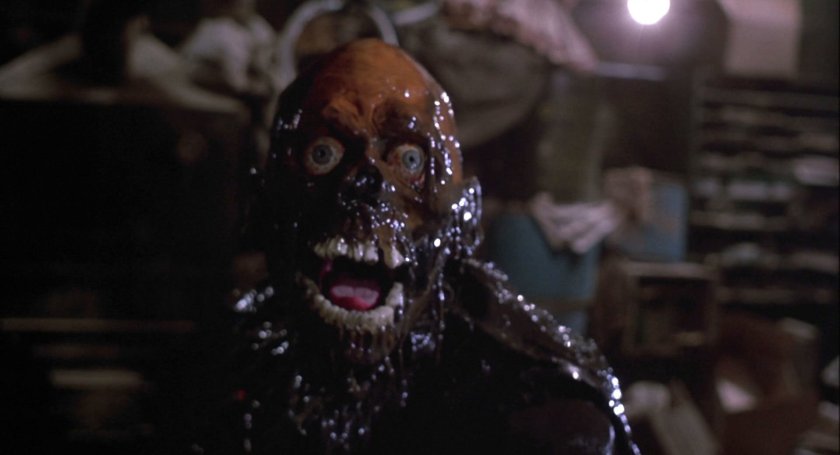
Return of the Living Dead (1985, Dan O’Bannon)
Okay, so it’s no Night of the Living Dead or Dawn of the Dead, but Dan O’Bannon’s Return of the Living Dead has different aspirations than those two zombie classics. O’Bannon doesn’t even pretend to make a serious horror movie; when he was offered the script it was a fairly run-of-the-mill rip-off of George Romero’s incomparable films, so he changed the tone entirely and turned it into a caustic punk horror-comedy.
Despite its lower profile compared to Romero’s work, the film did leave its mark on the standard depiction of zombies in one way: for the first time in any film, they exist to eat brains. The zombies are brought to life after a clumsy warehouse foreman accidentally releases toxic gas from a barrel containing a failed military experiment known as the “tar man.” The gas gets released into the air and soon acid rain carries it down to the local cemetery, at which point it’s up to a group of punks, the warehouse’s owner, and a mortician to fight back the undead uprising.
Like many other punk films from the early ‘80s and onwards, it does tend to exaggerate a bit in terms of what punks looked like: lots of mohawks, bizarre facial piercings, and leather-on-leather on display here. Some punk fashion was surely outrageous and flamboyant like that, but simple utilitarian clothing was more common – after all, punk is a genre by and for working-class youth, so t-shirts and buzzcuts were easier to spot in a mosh pit than Vivienne Westwood and liberty spikes.
That being said, the soundtrack is far more authentic; comprised of iconic punk and deathrock (read: a spooky punk subgenre crossing goth rock atmospherics with punk attitude) bands like The Cramps, T.S.O.L., 45 Grave, The Damned, and the Flesheaters, the more creepy and morbid angle to the music is incredibly fitting given the film’s careful balancing of outrageous gore and dark humor.
The technical term for the genre is “splatstick,” meaning it’s physical comedy where all the humor is derived from the comically extreme violence. No matter what kind of horrific dismemberment the humans inflict on the zombies they just don’t seem to die, but that isn’t for a lack of trying; pickaxes and saws come into play to spectacular effect, and the zombies get in on the carnage too when they graphically gnaw into people’s heads to get to their brains.
The mix of gleefully bloody zombie deaths and a kickass soundtrack is hardly enough to make the film a masterpiece, but it’s surely as wildly unpretentious and funny as zombie movies get.
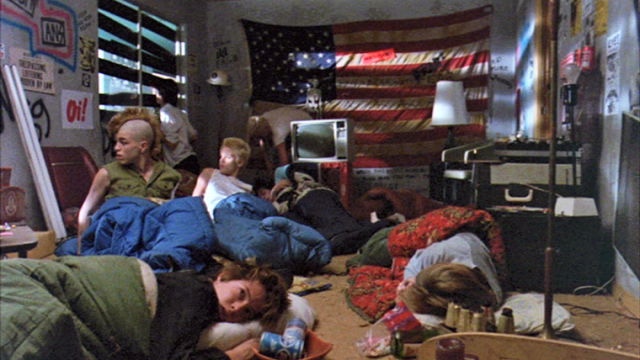
Suburbia (1984, Penelope Spheeris)
In terms of narrative films set in the LA hardcore scene, there are few as bleak as Suburbia; death and violence are present in every frame of the movie, and even the “good guys” are repulsively cruel at times. Dealing in everything from child abuse to self-harm, the film comes off as a nihilistic circus of horrors at first, but it’s ultimately marked by far more compassion and sympathy for its characters than is initially let on.
The plot traces a group of young punks who all ran away from their abusive or broken suburban households to squat in an abandoned house on the edge of town. Being young and reckless, they ultimately commit one too many petty crimes and draw the attention of a group of a violent men who make it their goal to drive the punks away via vigilante justice.
The film’s rawness is plainly evident throughout; rather than sugarcoating the punk scene and painting it as without flaws, director Penelope Spheeris shows the liberating aspects of punk as well as the darker side of the ‘80s hardcore scene. Above all else, the violent misogyny of the male-dominated scene is on full display and even the most sympathetic characters are guilty of participating in it.
Beyond the challenging content of the film, it’s extraordinarily gritty in its lower-than-low budget and non-professional cast made up of teenagers scouted out at local punk shows, among them future Red Hot Chili Peppers bassist Flea. The combination of all these factors aims to achieve a greater authenticity and truth in its depiction of the Los Angeles punk scene.
And Suburbia is nothing if not authentic to the spirit of punk, plainly rejecting commercial viability in favor of brutal melodrama – the film throws away any hopes of mainstream appeal when a rabid dog mauls an infant offscreen within the first five minutes – and featuring live performances by Southern California hardcore bands D.I., T.S.O.L., and The Vandals.
Despite its deeply troubling narrative, the film ultimately achieves an astounding emotional depth and ends up being almost akin to a modern Greek tragedy – it’s not feel-good by any means, but it’s surely among the most challenging and honest coming-of-age films of the punk era.

We Are The Best! (2013, Lukas Moodysson)
“Sweet” is hardly a typical descriptor of punk, a genre that for all intents and purposes is driven by rebellion and outrage, but We Are The Best! is an overwhelmingly sweet, heartfelt little punk movie.
It’s a little film mainly because it’s so closely focused on a small punk band with more passion than talent, but also because that band is made up of middle schoolers. The band gets off the ground when Bobo and Clara, two girls in 1982 Stockholm, start playing music together out of spite for their gym class and the boys in it who bully them because “punk is dead” (did Black Flag never tour in Sweden?). Their first song, fittingly given their feelings towards P.E., is called “Hate The Sport,” and it is understandably rough around the edges; it’s hard to have a punk band with only two members, especially if those members are 13-year-olds with no prior musical experience. So they recruit an unlikely third member, an ostracized ultra-Christian girl who knows how to play classical guitar, and they start to practice as a full band.
There are virtually no other major plot points to the film; aside from a brief dispute over some punk boys, the film just tracks their band and their friendship as they try to master their craft. That’s hardly to its detriment though, as a movie with characters this endearing and complex doesn’t need to have a lot of plot. The simplicity of the narrative makes it feel all the more warm and joyful; there’s no manufactured conflict inserted into the third act or a forced romantic subplot, just a straightforward story about three girls trying to leave their mark on the world in whatever way they can – which, in this case, ends up being rebelling against school and parents in a punk scene dominated by pretentious older boys.
It’s a movie about adolescent growing pains and finding one’s place in the world, which is hardly breaking new ground for coming-of-age stories but somehow feels new and different in this case. Maybe it’s the film’s sense of honesty and refusal to indulge in sentimentality; the girls aren’t great musicians at the start of the film and god knows they don’t become great musicians by the end of it, but the music itself ends up being less important than the catharsis they get from playing it.

